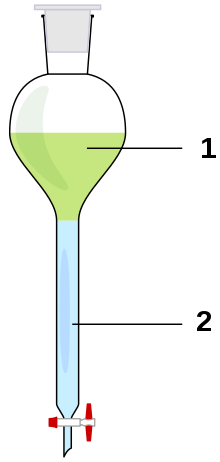Decantation

2. Lower phase

Decantation is a process for the separation of mixtures, by removing a layer of liquid, generally one from which a precipitate has settled. The purpose may be either to produce a clean decant, or to remove undesired liquid from the precipitate (or other layers). If the aim is to produce a clean solution, a small amount of solution must generally be left in the container, and care must be taken to prevent any precipitate from flowing with the solution out of the container.
Preliminary processes
A mixture of an insoluble solid in liquid is allowed to stand. The solid is insoluble and settles at the bottom if kept undisturbed for some time. This process is called sedimentation. A centrifuge may be useful in decanting a solution. The centrifuge causes the precipitate to be forced to the bottom of the container; if the force is high enough, the precipitate may form a compact solid. Then the liquid can be more easily poured away, as the precipitate will tend to remain in its compressed form. Similarly a mixture of two immiscible liquids can also be separated by decantation. For example, the oil and water extracted from fish may be decanted to obtain the oil. A mixture of kerosene and water can also be separated through decantation
Examples
It is frequently used to purify a liquid by separating it from a suspension of insoluble particles (e.g. in red wine, where the wine is decanted from the potassium bitartrate crystals). To obtain a sample of clear water from muddy water, muddy water is left in a container until the mud settles, and then the clear water is poured into another container.
Another example of decantation is the regeneration of used chiral stationary phase (CSP). The CSP to be decanted is gently mixed in a container with a compatible solvent to form a suspension. The suspension is allowed to rest for a period of time, after which the supernatant is carefully poured off. The supernatant contains the undesirable constituents of the former suspension, while the leftover sediment in the container is clean, reusable CSP. Decantation should be done directly after sedimentation. This process is also used in extracting pure iron from iron ore.
